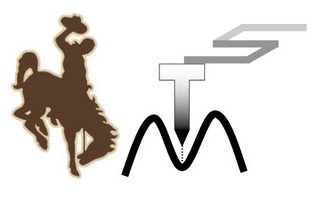Read more about XSTM/S in the Review Article: TeYu Chien et al., Adv. Funct. Mater. 23, 2565 (2013); Aaron Wang and TeYu Chien, Phys. Lett. A 382, 739 (2018); and in the book chapter: TeYu Chien, (2018) "Nanostructured Oxides: Cross-Sectional Scanning Probe Microscopy for Complex Oxide Interfaces." In: Balasubramanian G. (eds) "Advances in Nanomaterials." Springer, Cham..
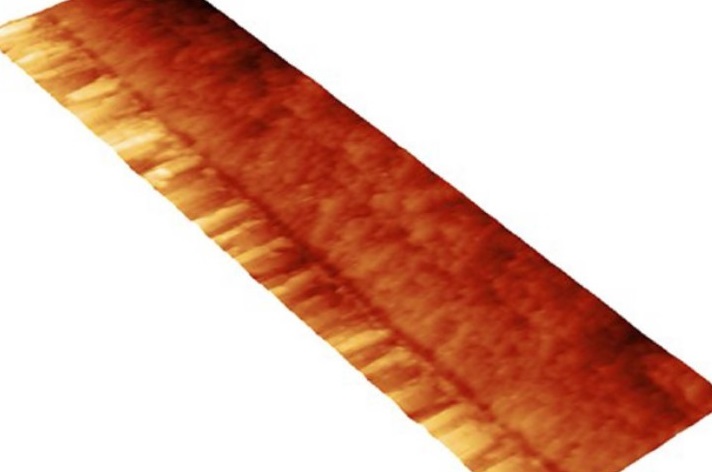
|
Built-in Electric Field Alters the Mechanical Properties in NanoscaleThe mechanical properties of materials could be influenced and controlled by both extrinsic and intrinsic factors. The extrinsic factors, such as grain sizes and defect densities, affects materials with larger scale. For nano-materials, the extrinsic factors are minimum so intrinsic factors, such as inter-atomic bond lendth and strength, dominate. On the other hand, the effects of the electric field on the mechanical properties are relatively unexplored in literature. Even for the existing reports, there are no clear overview of how the electric field could alter the mechanical properties, albeit the effect is evident. Here, we use XSTM/S to study the interfaces between LaNiO3 (LNO) and Nb-doped SrTiO3 (Nb:STO) and revealed that the built-in electric field formed at the interfaces altered the mechanical properties of Nb:STO with 6 nm away from the interfaces. The mechanism is discussed to be related to the change of the bond length due to the electric field. Also, the same picture could be used to explain the existence of the dielectric deadlayer found at the interfaces of STO with metallic materials. This finding is the first experimental evidence on the effects of the electric field on the mechanical properties in nano-scale. The results are important for the applications involving electronic and mechanical properties, such as nano-electromechnical systems (NEMS). Read more: TeYu Chien et al., Sci. Rep. 6, 19017 (2016). |
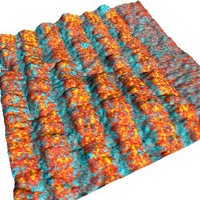
|
Short Range Charge Transfer at Complex Oxide Based Superconductor-Ferromagnetic Metal InterfacesThe interplay between ferromagnetism (FM) and superconductivity (SC), the so called proximity effect, has been the focus of fundamental and application research for decades. In systems with conventional superconductors and ferromagnetic metals, the understanding of proximity effect is somewhat satisfied. However, it is not the case in complex oxide based SC-FM systems. Controversial reports regarding the length scale of the proximity prove that the microscopic understanding is the key. Since complex oxides involve too many degrees of freedom in affecting the physical properties, information about the isolated degree of freedom, such as charge transfer length scale, provides an important piece of information to solve the puzzle. Here, we utilized XSTM/S along with scanning trasmission electron microscope (STEM) with electron energy loss spectroscopy (EELS) to study the interfaces of YBa2Cu3O7-δ/La2/3Ca1/3MnO3. Our results show a short range (< 1 nm) charge transfer length scale. This direct probing method provides an unambiguous evidence of the charge transfer length scale and is an important step toward understand the proximity effect at complex oxide based SC-FM interfaces. Read more: TeYu Chien et al., Nature Commun. 4, 2336 (2013). |
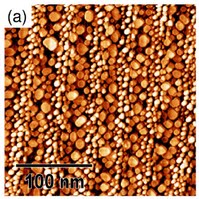
|
Controlling the Fe Films Deposited on Striped-Termination on Fractured SrTiO3 SurfacesThough the formation mechanism of the striped-termination on the fractured SrTiO3 (STO) surfaces is still unclear, it could be used for controlling the morphology of the deposited Fe films on the fractured STO surfaces. By utilizing STM, the evolution of the Fe film morphology was revealed under heat treatment in ultrahigh vacuum (UHV) environment. The comparison to the high temperature evolution of the bare fractured STO further concludes that the interfacial energy of Fe/SrO interface is higher than that of Fe/TiO2 interface. This result demonstrates an efficient way of controlling/fabricating nano-particles on a large area, nano-scale ordered, and self-assembled striped-termination surface. Read more: TeYu Chien et al., Appl. Phys. Lett. 100, 031601 (2012). |
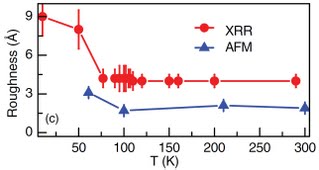
|
Correlation Between Surface Rumpling and Structural Phase Transition in SrTiO3SrTiO3 (STO) is one of the most common substrates used for epitaxial-grown complex oxide thin films. The interfaces in many complex oxides are found to exhibit a variety of novel phenomena. The surface termination, morphology, and chemical stoichiometry play decisive roles on engineering the interface properties. Thus, the understanding of the surface condition is an essential task for further precise interface engineering. STO has a structural phase transition at around 105 K. In our study, we found two different length scales of rumpling occurring at two different temperatures (105 K and 77 K). The 105 K is related to the bulk structural phase transition, while the 77 K is something else. Read more: S. Singh et al., Phys. Rev. B 85, 115450 (2012). |
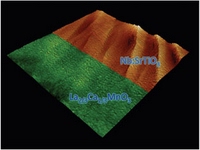
|
Directly Probing Complex Oxide Interfaces With XSTMBy utilizing the fracturing technique for complex oxides, the STM now is able to probe the interface of PLD grown epitaxial films with substrates. The first demonstration on harness XSTM on complex oxide interfaces is done in our lab with La2/3Ca1/3MnO3 (LCMO) film grown on Nb-doped SrTiO3 (Nb:STO) substrate. The observed abrupt morphology changes across the interface is mainly due to the different fracturing toughness between film material and substrate material. Further more, by measuring tunneling spectrum across the interfaces with scanning tunneling microscopy (STS), the valence and conduction band of the two materials could be extracted. Thus the band diagram (spatial evolution of the energy bands across the interface) could be directly probed. This opens a new route to study the energy band bending at complex oxide interfaces. Read more: TeYu Chien et al., Phys. Rev. B 82, 041101(R) (2010). |

|
Long Range Chemical Stripes on Fractured Nb-doped SrTiO3SrTiO3 (STO) has been intensively studied and widely used as substrate for growing variety of perovskite films. The crystal structure of STO is constructed by stacking TiO2 and SrO layers alternatively. The surfaces of the as made STO single crystal specimens are composed of mixture (randomly) of two types of terminated surfaces. It has been demonstrated that chemical treatment on the surfaces of STO could result in uniform TiO2 terminated surfaces. In our lab, we found that by mechanically fracturing Nb-doped STO, mixed SrO- and TiO2- terminated surfaces are formed. Read more: (1) N. P. Guisinger et al., ACS nano 3, 4132 (2009); (2) TeYu Chien et al., J. Vac. Sci. Technol. B 28, C5A11 (2010). |
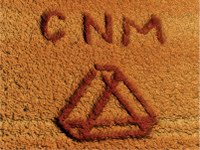
|
NanoLithography on Nb-doped SrTiO3 Using STM TipThe tip-sample interaction is a nontrivial issue that need extra care when using STM. The high bias voltage could result in material transferring back and forth from tip and sample surfaces. In our lab, we demonstrated the tip-sample interaction could be controlled by selecting appropriate sample-tip bias and duration of the acting voltage pulses. To have an ideal surface for nanolithography by STM tip, large terrace size is needed. Contrast to the small terrace sizes shown above (fractured at room temperature), by fracturing at low temperature (~50 K), the resulting sizes of the terraces could be found up to ~500 nm. Read more: (1) TeYu Chien et al., Appl. Phys. Lett. 95, 163107 (2009); (2) TeYu Chien et al., Proc. SPIE 7940, 79400T (2011). |
